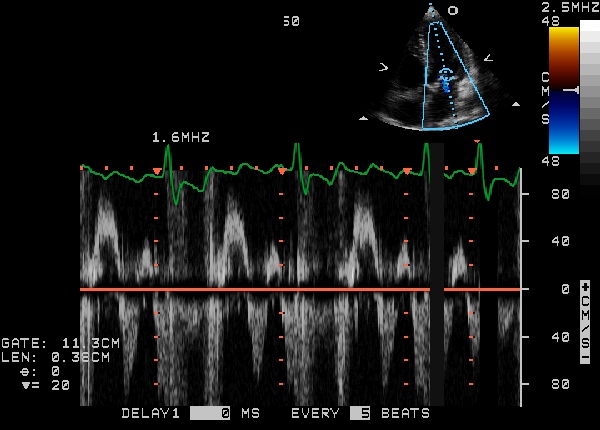Aortic stenosis echocardiography: Difference between revisions
No edit summary |
No edit summary |
||
| Line 53: | Line 53: | ||
'''4.''' Echocardiography is recommended for the assessment of changes in hemodynamic severity and left ventricular function in patients with known [[aortic stenosis]] during pregnancy. ''([[ACC AHA guidelines classification scheme#Level of Evidence|Level of Evidence: B]])'' | '''4.''' Echocardiography is recommended for the assessment of changes in hemodynamic severity and left ventricular function in patients with known [[aortic stenosis]] during pregnancy. ''([[ACC AHA guidelines classification scheme#Level of Evidence|Level of Evidence: B]])'' | ||
'''5.''' Transthoracic echocardiography is recommended for re-evaluation of asymptomatic patients: every year for severe [[aortic stenosis]]; every 1 to 2 years for moderate [[aortic stenosis]]; and every 3 to 5 years for mild [[aortic stenosis]]. ''([[ACC AHA guidelines classification scheme#Level of Evidence|Level of Evidence: B]])''}} | '''5.''' Transthoracic echocardiography is recommended for re-evaluation of asymptomatic patients: every year for severe [[aortic stenosis]]; every 1 to 2 years for moderate [[aortic stenosis]]; and every 3 to 5 years for mild [[aortic stenosis]]. ''([[ACC AHA guidelines classification scheme#Level of Evidence|Level of Evidence: B]])'' | ||
===[[ACC AHA guidelines classification scheme#Classification of Recommendations|Class IIa]]=== | |||
'''1.''' Dobutamine stress echocardiography is reasonable to evaluate patients with low-flow/low-gradient aortic stenosis and [[left ventricular dysfunction]]. ''([[ACC AHA guidelines classification scheme#Level of Evidence|Level of Evidence: B]])''}} | |||
==Examples== | ==Examples== | ||
Revision as of 19:40, 9 April 2012
|
Aortic Stenosis Microchapters |
|
Diagnosis |
|---|
|
Treatment |
|
Percutaneous Aortic Balloon Valvotomy (PABV) or Aortic Valvuloplasty |
|
Transcatheter Aortic Valve Replacement (TAVR) |
|
Case Studies |
|
Aortic stenosis echocardiography On the Web |
|
American Roentgen Ray Society Images of Aortic stenosis echocardiography |
|
Directions to Hospitals Treating Aortic stenosis echocardiography |
|
Risk calculators and risk factors for Aortic stenosis echocardiography |
Editor-In-Chief: C. Michael Gibson, M.S., M.D. [1]; Mohammed A. Sbeih, M.D. [2]
Overview
Echocardiography may be used as a diagnostic tool in the evaluation of aortic stenosis. As an evaluative tool, echocardiograms can identify functionality issues within the heart's anatomy. An aortic stenosis patient will present symptomatic evidence of a pressure gradient, the result of left ventricular hypertrophy.
Echocardiogram
Echocardiogram is the best non-invasive test to evaluate the aortic valve anatomy and function.
2D Echocardiography of the aortic valve in the parasternal long axis view demonstrates right and non coronary leaflets. In the parasternal short axis view, leaflets open equally and forms a circular orifice during systole. During diastole, the normal leaflets form a three pointed star with prominence at the closing point (nodules of Arentius).
Severity of Aortic Stenosis
Aortic stenosis severity can be assessed by estimating both the pressure gradient across the valve and the surface area of the valve.
- Using echocardiographic flow velocities, the aortic valve area can be calculated non-invasively to estimate the severity of aortic stenosis.
- Using the velocity of the blood through the valve, the pressure gradient across the valve can be calculated by the equation:
Gradient = 4(velocity)² mmHg
Normal Aortic Valve:
- A normal aortic valve has no gradient, and
- Aortic valve surface area is of 2.5 to 3.5 cms2.
Mild Aortic Stenosis:
- Mean pressure gradient across the valve is less than 25 mm Hg, or
- Valve surface area is between 1.5 and 2.5 cms2, or
- Jet velocity less than 3.0 m per second
Moderate Aortic Stenosis:
- Mean pressure gradient across the valve is between 25 mm Hg and 40 mm Hg, or
- Valve surface area is between 1.0 and 1.5 cms2, or
- Jet velocity 3.0 to 4.0 m per second
Moderate to Severe Aortic Stenosis
- Valve surface area is between 0.7 and 1.0 cms2
Severe Aortic Stenosis:
- Mean pressure gradient across the valve is more than 40 mm Hg, or
- Valve surface area is less than 0.7 cm2, or
- Jet velocity is greater than 4.0 m per second
ACC/AHA Guidelines- Echocardiography (Imaging, Spectral, and Color Doppler) in Aortic Stenosis [1]
| “ |
Class I1. Echocardiography is recommended for the diagnosis and assessment of aortic stenosis severity. (Level of Evidence: B) 2. Echocardiography is recommended in patients with aortic stenosis for the assessment of left ventricular wall thickness, size, and function. (Level of Evidence: B) 3. Echocardiography is recommended for re-evaluation of patients with known aortic stenosis and changing symptoms or signs. (Level of Evidence: B) 4. Echocardiography is recommended for the assessment of changes in hemodynamic severity and left ventricular function in patients with known aortic stenosis during pregnancy. (Level of Evidence: B) 5. Transthoracic echocardiography is recommended for re-evaluation of asymptomatic patients: every year for severe aortic stenosis; every 1 to 2 years for moderate aortic stenosis; and every 3 to 5 years for mild aortic stenosis. (Level of Evidence: B) Class IIa1. Dobutamine stress echocardiography is reasonable to evaluate patients with low-flow/low-gradient aortic stenosis and left ventricular dysfunction. (Level of Evidence: B) |
” |
Examples
Demonstration of Diastolic Mitral Regurgitation due to Severe Aortic Stenosis

Demonstration of Aortic regurgitation combined with Aortic Stenosis
{{#ev:youtube|J-Qs_evodww}}
Demonstration of Calcific Aortic Stenosis with Mitral Annular Calcification and Moderate Mitral Regurgitation
{{#ev:youtube|qjpV19034sk}}
References
- ↑ Bonow RO, Carabello BA, Chatterjee K, de Leon AC, Faxon DP, Freed MD; et al. (2008). "2008 focused update incorporated into the ACC/AHA 2006 guidelines for the management of patients with valvular heart disease: a report of the American College of Cardiology/American Heart Association Task Force on Practice Guidelines (Writing Committee to revise the 1998 guidelines for the management of patients with valvular heart disease). Endorsed by the Society of Cardiovascular Anesthesiologists, Society for Cardiovascular Angiography and Interventions, and Society of Thoracic Surgeons". J Am Coll Cardiol. 52 (13): e1–142. doi:10.1016/j.jacc.2008.05.007. PMID 18848134.